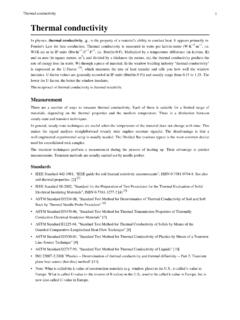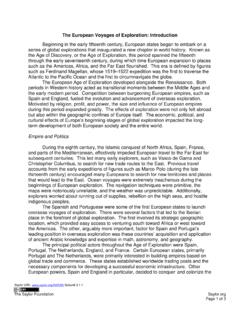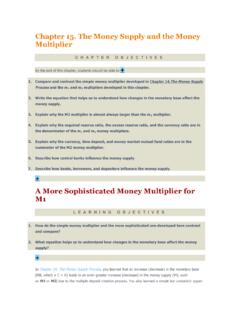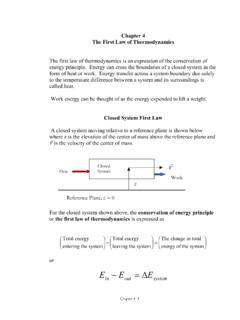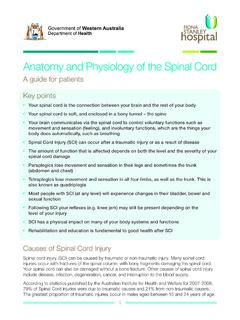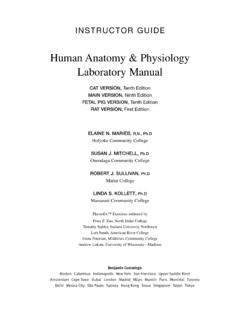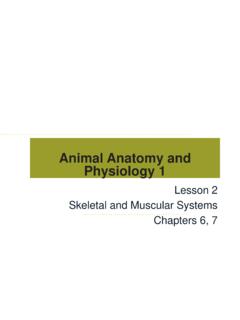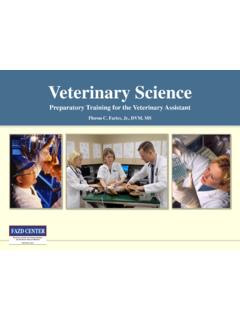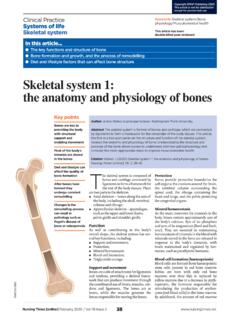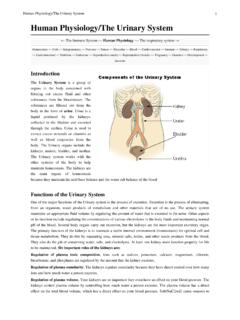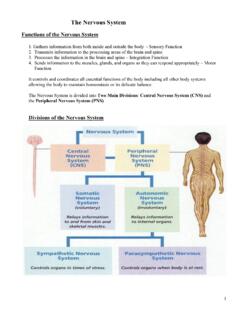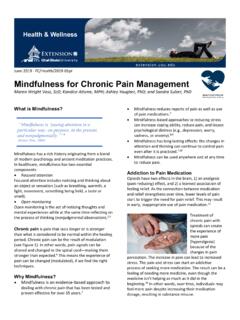Transcription of Chapter 1: Introduction to Human Anatomy and Physiology
1 Source URL: Saylor URL: Attributed to: [The Biology Corner] Page 1 of 5 Anatomy and Physiology The Biology Corner Chapter 1: Introduction to Human Anatomy and Physiology Anatomy : Structure of Body Parts. Morphology Physiology : Function of body parts. What they do and how. *A & P are very closely related - structure closely related to function Characteristics of Life Movement - self initiated change in position, motion of internal parts Responsiveness (irritability) - Ability to sense changes within, or around the organism and react to them Growth - increase in body size Reproduction - Parents produce offspring / producing new individuals Respiration - Obtaining oxygen (O2), using it to release energy from food substances, and getting rid of wastes Digestion - Chemically changing (breaking down) food substances, and getting rid of wastes Absorption - Passage of Digested products (food substances) through membranes and into body fluids Circulation - Movement of substances throughout the body Assimilation - Changing absorbed substances into chemically different substances Excretion - Removal of wastes METABOLISM.
2 All physical and chemical changes occuring in an organism Needs: Water, food, oxygen, heat, pressure - all must be regulated HOMEOSTASIS: Tendency of the body to maintain a stable, balanced internal environment. Accomplished through self regulating adjustments Levels of Organization (from simplest to most complex) Source URL: Saylor URL: Attributed to: [The Biology Corner] Page 2 of 5 Atoms --> Molecules --> Macromolecules --> Organelles --> Cells --> Tissues --> Organs --> Organ Systems --> Organism *A group (mass) of cells working together to carry out certain common functions form a tissue *A group of tissues working together to carry out certain common functions form an organ *A group of General Organization of the Body: Axial Portion - head, neck, trunk Appendicular Portion - arms & legs 1. Several body cavities 2. Layers of membranes within cavities 3. Variety of organs and organ systems within cavities (VISCERA = internal organs.)
3 "Visceral organs") Body Cavities (see ) A. Dorsal Cavity ---Cranial Cavity - Brain, spinal Cavity - spinal cord B. Ventral Cavity 1. Thoracic Cavity - right and left compartment separated by mediastinum. Heart , lungs, esophagus, trachea 2. Abdominopelvic Cavity ---Abdominal cavity - stomach, spleen, liver, gall bladder, small intestine ---Pelvic cavity - part of the large intestine, urinary bladder, reproductive organs *Thoracic and abdominopelvic cavity separated by DIAPHRAGM *The organs within the cavities are surrounded by a type of two layered membrane called the SEROUS MEMBRANE Source URL: Saylor URL: Attributed to: [The Biology Corner] Page 3 of 5 *The outer lyer of each membrane is called the PARIETAL layer and forms a "lining" against the inner wall of each cavity *The inner layer of each membrane covers the surface of each organ and is called the VISCERAL layer Membranes: 1. Pleura (or pleural membrane) - surrounds the lungs --outer layer = parietal pleura --inner layer = visceral pleura 2.
4 Pericardium (or pericardial membrane) - surrounds the heart --outer layer = parietal pericardium --inner layer = visceral pericardium 3. Peritoneum (or peritoneal membrane) - surrounds all the organs within the abdominopelvic cavity --outer layer = parietal peritoneum --inner layer = visceral peritoneum *Between the layers of each membrane is a lubricating fluid which is called SEROUS FLUID ORGAN SYSTEMS 1. Integumentary Body covering. Skin, hair, nails, sweat glands. Function: protect underlying tissues and regulate body temperature 2. Skeletal Bones, ligaments, cartilage Function: Support, movement, protection, and production of blood cells 3. Muscular Muscles of the body Function: Movement, maintenance of posture, production of body heat 4. Nervous Brain, spinal cord , nerves through the body Function: Communication throughout body, mental activities, maintaining homeostasis 5. Endocrine Ductless glands = pituitary, adrenal, thyroid, parathyroid, pancreas, ovaries, testes, thymus, pineal glands Function: Secretion of hormones, communication between body parts 6.
5 Digestive Mouth, teeth, pharynx, esophagus, stomach, small intestine, large intestine, liver, gall bladder, and many glands including the pancreas Function: Breakdown of food substances into simpler forms that can be absorbed (digestion). Source URL: Saylor URL: Attributed to: [The Biology Corner] Page 4 of 5 7. Circulatory Heart, blood vessels, blood. Function: Transports materials throughout the body. *Lymphatic system usually included with the circulatory system 8. Urinary Kidneys, ureters, urinary bladder, urethra Function: Removes ("filters") wastes from the blood and helps maintain the body's water and electrolyte balance 9. Reproductive Reproductive organs, primarily the ovaries (females) and testes (males) Function: Produce special reproductive cells for reproduction Source URL: Saylor URL: Attributed to: [The Biology Corner] Page 5 of 5 Anatomical Terminology: Anatomical Position = standing erect, face forward, arms at side, palms facing forward *Study and learn the following terms which are used to describe relative positions -- location of one body part with respect to another ( -14) 1.
6 Superior 5. Medial 9. Superficial 2. Inferior 6. Lateral 10. Deep 3. Anterior 7. Proximal 4. Posterior 8. Distal *Learn and understand the following body sections ("slices") through th body for observing internal structures 1. Sagittal 2. Transverse 3. Frontal (or coronal)


